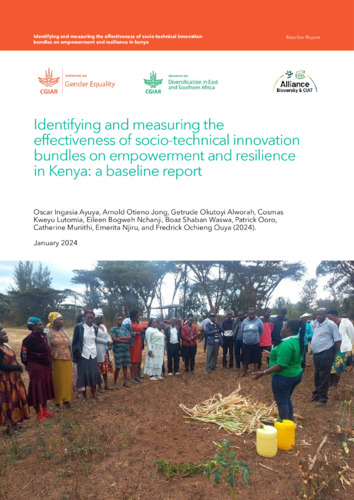Identifying and measuring the effectiveness of socio-technical innovation bundles on empowerment and resilience in Kenya: A baseline report
Abstract
The study revealed that 63% of the surveyed farmers adopted STIBs. STIBs adoption was higher among UU farmers (98%) compared to non-UU farmers (33%) which could be attributed to their participation in the UU initiative. STIBs adoption rate among women in Embu and Makueni was slightly lower than the rate of STIBs among men. This suggests possible underlying socioeconomic issues obstructing women from using STIBs. More (45%) non-UU farmers in Embu adopted STIBs compared to Nakuru (38%) and Makueni (17%). Technological innovations as components of STIBs were the most adopted (99%) compared to social innovations (89%) and technical innovations (72%). UU farmers had
higher adoption rates of the different innovation components of STIBs. The disparities in use of The study was conducted in Embu (Runyenjes and Manyatta sub-counties), Makueni
(Makueni and Mbooni sub-counties), and Nakuru (Rongai, Njoro and Gilgil sub-counties) counties in Kenya. vi Baseline Report | January 2024 STIBs components between UU and non-UU farmers could be attributed to better access to information and support provided through the UU initiative. In terms of numbers adopted, farmers reported an average of 3 to 7 technological innovations and 1 to 3 technical and social bundles. The UU farmers had a higher number of technological, technical, and social innovations compared to non-UU farmers. Most farmers have used STIBs within the last two years as evidenced by 63% of non-UU farmers and 70% of the UU farmers. There was a total of 485 unique STIBs in the
dataset with majority (69%) reported by women and UU farmers (71%). About 40% of the STIBs were reported in Nakuru County. Improved seed, farmer training, and group membership were the most used STIBs by farmers (9 farmers out of 499 STIBs adopters) across the learning labs. Majority of the STIBs were reported women (69%) and UU
farmers (71%). Effectiveness of UU and HER+ initiatives Productivity was higher in baby demonstration plots than in general plot. Bean productivity in from demo was 64% higher than harvest from general plot. Maize productivity for UU baby demonstration plots 81% higher than maize harvested from the general plot. This demonstrates the effectiveness of the interventions by the initiatives to enhance productivity. There was a narrow gender gap in bean productivity in baby demonstration plots compared to bean productivity in the general plot. Farmers experimented with four out of the six CA no till (NT) ripping practices on farmers’ fields. The most selected and experimented CA practice on the baby demo was the standard maizecommon bean intercrop as reported by 49% of UU farmers. Strip cropping common bean-maize strips, common bean-maize intercrop double row configuration, and continuous maize were experimented by 32%, 13%, and 2% of the UU farmers in Nakuru respectively.

